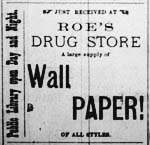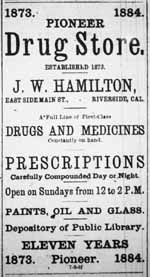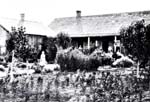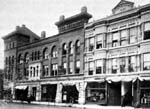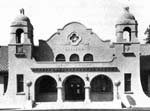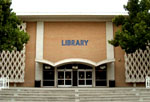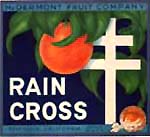
Historical Scrapbook:
RIVERSIDE LIBRARIES 1873-1903
The library buildings 1870-1903
House of Judge John W. North on Vine Street. As soon as he build his house in 1871, North designated his parlor as the settlement's reading room.
Photo from Stonehouse 1965.
The Sixth Street School 1898.This is the later structure built on the foundations of the earlier school built in 1871.
Riverside Daily Press Annual. 1898. Riverside Public Library
The Loring Building 1888. Besides Riverside Public Library the building was also a home to Riverside Opera.
Photo from Baker 1988.
Riverside's Carnegie Library. In 1903, Riverside Public Library finally acquired its own building with 20,000-volume capacity.
Photo from Klutz 1972.
Riverside Public Library today. The building is know as the Main Library.
Photo Vlasta Radan, 2006.
The first library building in Riverside was a parlor in the house of John W. North on Vine Street, on the eastern edge of the Mile Square, as downtown Riverside is known. In the 1873, a group of citizens put together a small book collection and arranged for it to be shelved in the local schoolhouse. The space was too small to allow for a separate reading room. The operation of the library relied completely on the enthusiasm of the volunteers and there were no arrangements for any systematic funding.
On July 15, 1879 Elmer W. Holmes and Albert S. White, together with some other leading citizens of Riverside formally founded a subscription library named the Riverside Library Association. James H. Roe, local druggist, teacher, and newspaperman, agreed to act as librarian for the Association. The collection was stored in the back of his shop and books were accessible “day and night.”
In 1882, Roe resigned as librarian, and the collection was moved to the drug store of John W. Hamilton. After initial financial troubles, the book collection of Library Association eventually grew up to 1,000 volumes. However, on October 12, 1884, a big fire broke out and Hamilton’s store was greatly damaged. Through the effort of the citizens, the majority of books in the collection were saved, but the Library Association never quite recovered. After a while, the reminder of the collection was boxed and stored around the town.
In 1888, through the effort of Holmes and White, the stockholders of the Library Association agreed to offer their book collection to the City with the condition that the City organize and maintain a free public library. On the July 8, 1888, the City Board of Trustees accepted the offer and named the Library committee. It was decided that the library would be financed by levying a library tax. After six months of organizing and repairing of the collection, the library finally opened its door on June 1, 1889, in two small rooms at the back of the second floor of the Handy Building” (Baker 1998, p. 7). The space was small and did not allow for much more than shelving of the collection.
In January 1890, the library moved to the Loring Building, on the corner of Main and Seventh streets. The building was erected by the Loring Opera House Company and was main cultural center of the town. In its 1891 Annual, the Riverside Daily Press described the 90 x 45 feet room as “provided and elegantly fitted for library use” (p. 36). The size of the rented rooms finally enabled space for a reading room. The library proved very popular, and in the first year, it circulated over 17,000 volumes. At that time, Riverside had less than 5,000 citizens, and library patrons were allowed to borrow only one book at a time (Baker 1988, p. 8).
In the 1899, the Women’s Club started an initiative to secure one of Carnegie grants that he was offering towns that wanted to build library buildings. However, it took cooperation of wider community, notably the City Board of Trustees to secure the $20.000 grant. In return for the grant, the town promised to provide adequate finance for regular operation and maintaining of the library. The building was erected in the downtown block between Sixth and Seventh and Lime and Orange streets, next to Mission Inn hotel. The Los Angeles firm of Burnham & Bliesner won the competition for their design of the building in “mission revival” style. As the Riverside Daily Press reported on the February 13, 1903, the Library Board decided to engage the S.S. Nicolini for interior design of the building. The general color scheme was to be lilac, olive, and amber, creating “a sort of Beethoven sonata set to color.” A cost for the decoration in amount of $2,000 was raised by a “public subscription.” On July 31, 1903, a new “building in which every loyal Riversider takes honest pride” was officially opened, all decorated, furnished and with books neatly shelved. The building was expanded in 1909 and again in 1921.
In 1961, the “Riversiders” voted to approve the bond issue for the financing of the new library building which was built just behind the old Carnegie building. The new library, called now Central or Main library opened its door on March 21, 1965. Unfortunately, the old Carnegie building was demolished so only few objects were preserved, notably the stained glass lights that stood at the front entrance of the Carnegie building. The oak table and some chairs from the old Carnegie reading room are now in the Local History section of the library and are still used by the patrons of the library.
Text, design, and digital imaging by Vlasta Radan.
Last update May 4, 2006.

